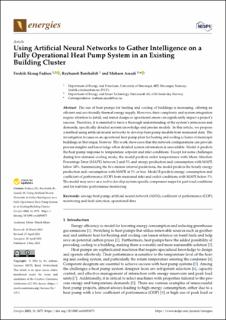| dc.contributor.author | Fadnes, Fredrik Skaug | |
| dc.contributor.author | Banihabib, Reyhaneh | |
| dc.contributor.author | Assadi, Mohsen | |
| dc.date.accessioned | 2023-05-10T06:53:49Z | |
| dc.date.available | 2023-05-10T06:53:49Z | |
| dc.date.created | 2023-05-09T10:53:04Z | |
| dc.date.issued | 2023 | |
| dc.identifier.citation | Fadnes, F. S., Banihabib, R., & Assadi, M. (2023). Using Artificial Neural Networks to Gather Intelligence on a Fully Operational Heat Pump System in an Existing Building Cluster. Energies, 16(9), 3875. | en_US |
| dc.identifier.issn | 1996-1073 | |
| dc.identifier.uri | https://hdl.handle.net/11250/3067396 | |
| dc.description.abstract | The use of heat pumps for heating and cooling of buildings is increasing, offering an efficient and eco-friendly thermal energy supply. However, their complexity and system integration require attention to detail, and minor design or operational errors can significantly impact a project’s success. Therefore, it is essential to have a thorough understanding of the system’s intricacies and demands, specifically detailed system knowledge and precise models. In this article, we propose a method using artificial neural networks to develop heat pump models from measured data. The investigation focuses on an operational heat pump plant for heating and cooling a cluster of municipal buildings in Stavanger, Norway. The work showcases that the network configurations can provide process insights and knowledge when detailed system information is unavailable. Model A predicts the heat pump response to temperature setpoint and inlet conditions. Except for some challenges during low-demand cooling mode, the model predicts outlet temperatures with Mean Absolute Percentage Error (MAPE) between 2 and 5% and energy production and consumption with MAPE below 10%. Summarizing the five-minute interval predictions, the model predicts the hourly energy production and consumption with MAPE at 3% or less. Model B predicts energy consumption and coefficient of performance (COP) from measured inlet and outlet conditions with MAPE below 5%. The model may serve as a tool to develop system-specific compressor maps for part-load conditions and for real-time performance monitoring. | en_US |
| dc.language.iso | eng | en_US |
| dc.publisher | MDPI | en_US |
| dc.rights | Navngivelse 4.0 Internasjonal | * |
| dc.rights.uri | http://creativecommons.org/licenses/by/4.0/deed.no | * |
| dc.title | Using Artificial Neural Networks to Gather Intelligence on a Fully Operational Heat Pump System in an Existing Building Cluster | en_US |
| dc.type | Peer reviewed | en_US |
| dc.type | Journal article | en_US |
| dc.description.version | publishedVersion | en_US |
| dc.rights.holder | The authors | en_US |
| dc.subject.nsi | VDP::Teknologi: 500 | en_US |
| dc.source.volume | 16 | en_US |
| dc.source.journal | Energies | en_US |
| dc.identifier.doi | 10.3390/en16093875 | |
| dc.identifier.cristin | 2146369 | |
| cristin.ispublished | true | |
| cristin.fulltext | original | |
| cristin.qualitycode | 1 | |

